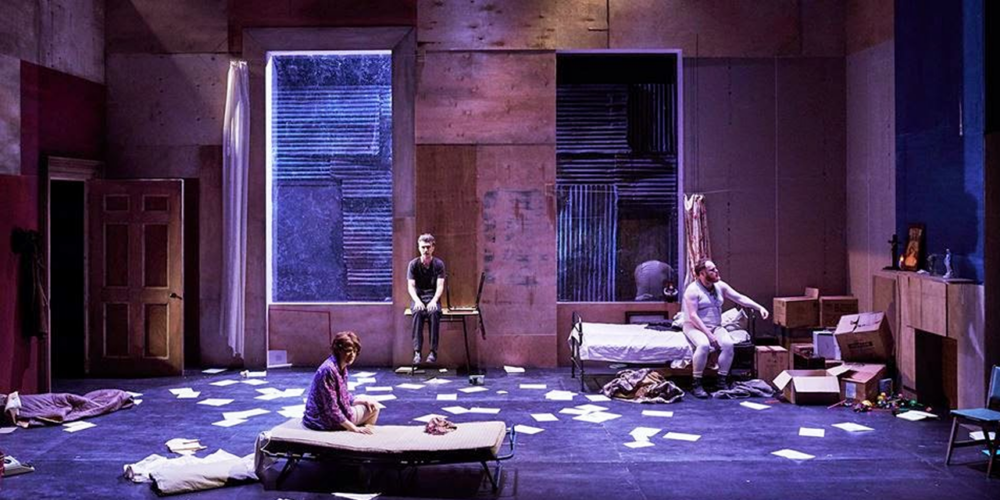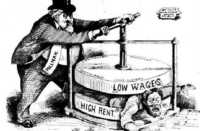Sean O’Casey’s play The Shadow of a Gunman premiered 100 years ago, on April 12, 1923, at the Abbey Theatre.
It is set during the War of Independence in a Dublin tenement. Davoren, writer of romantic verse, shares a room with Seumas, a peddler and onetime patriot who has now retreated into religion, superstition and bed. The other tenants believe Davoren is an IRA man on the run and assure him of their support. Flattered, he does not contradict them, and the ardent young patriot Minnie Powell falls in love with him.
Other tenants include: Mr. Grigson, an alcoholic loyalist, adored by his wife Mrs. Grigson; Mrs. Henderson, admirer of the clerk Mr. Gallogher and his imagined literary skills; and, in addition to Minnie, Tommy Owens, who repeatedly declares his willingness to die for Ireland. They all crave some glamour from the supposed gunman Davoren.
A friend of Seumas, Maguire, arrives and leaves a bag of peddler’s goods, he says. When news arrives that Maguire has been killed in a robbery, it becomes clear that he was a genuine IRA gunman. British troops storm the tenement. Seumas and Davoren discover to their horror that the bag contains bombs. The men are now desperate to get rid of the bag, and Minnie bravely hides it in her room without the men stopping her. The soldiers terrorise the tenants and discover the bombs. Minnie is arrested and accidentally shot when the IRA ambushes the British while they are taking Minnie away. The women, especially Mrs. Henderson, stand up to the invaders while the men grovel before them.
O’Casey portrays life in the Dublin slums as characterised by poverty and lack of prospects, war, terror, and violent death. Their inhabitants do not seem to offer much resistance. The actual freedom fighter Maguire passes unrecognised through their midst, while the mechanisms of oppression are massively present, especially the British army. O’Casey, in contrast to the romantic image of a united, heroic people, draws disunity, escapism, disillusionment on the one hand, and illusions on the other, lack of leadership, and the inability to realistically confront one’s own situation.
Early on in the play, Gallogher writes to the IRA, complaining about neighbours, people of his own class, in which he asks the IRA to intervene using force. His incomprehensibly phrased letter earns the neighbours’ admiration. Fascination with the word, form, ritual, is reinforced by a lack of education and religion. Minnie Powell also defies her own common sense: she falls in love with the romantic myth of the freedom fighter and his devoted lover, who is willing to sacrifice her life for him – an image she has absorbed from an early age in songs and stories.
Belief in the power of the word, the sign, is put to the test and proves useless. Neither the holy statues and images in Seumas’ room nor their ‘loyalist’ counterparts protect the tenants from the arbitrariness of the British soldiers, who throw the Bible on the floor and force Grigson to pray and sing for their amusement – now the Word is controlled by the enemy. And Davoren’s name on Minnie’s chest does not protect her from the fatal bullet.
O’Casey creates multiple parallels in this play, which on the one hand serve to generalise the action, but also contribute to a comic-grotesque aspect to the tragedy. This helps create a distance from the action and the characters, allowing the audience to see more clearly what the playwright is saying, ultimately helping them to confront these weaknesses.
Donal Davoren and Seumas Shields are people of intellectual and cultural ambition and insight who could be leaders in the eyes of the community from which they came – they share certain qualities with the people. Yet there is a contradiction between insight and action. Seumas has withdrawn from life and responsibility and he fails to recognise Maguire’s true character. Seumas, too, is a shadow of what he might have been. Davoren initially appears different. He has the will and the ability to free others from their ignorance, but he does not live up to his responsibility. His responsibility for the tragedy is all the greater. Maguire, however, is not presented as an alternative. His brief action seems thoughtless. He is as responsible for Minnie’s death as Davoren is. The national liberation movement fails to reach the broad masses of the people: Maguire moves through them fleetingly and unrecognised. The real and the fake gunman overshadow the play, and Seumas asserts that the gunmen do not die for the people, but the other way around. Minnie is shot not by the British but by the ‘real’ gunmen. The tragedy is that the people have no leaders who are in tune with them and the times. Their best leaders were executed in 1916. Nevertheless, all the human qualities necessary for liberation are there and embodied in the people as potential.
These include above all women, their lack of self-absorption, their capacity for loyalty, responsibility and self-sacrifice, their courage, their undamaged interest in poetry. But important qualities are common to both genders. A spontaneous solidarity, for example, prevents all the slum dwellers from betraying Davoren. Minnie and Maguire sacrifice their lives for something beyond themselves that they believe will bring liberation. In his creation of contradictory, realistic characters, O’Casey builds a growing awareness of a possible alternative inherent in things as they are.






